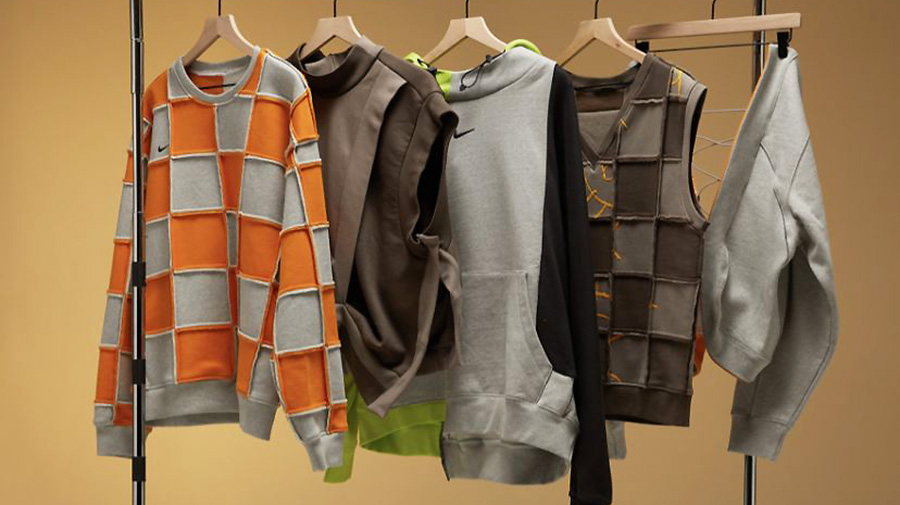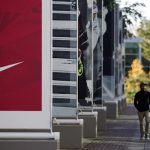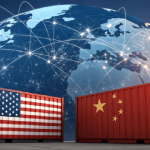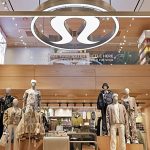In Kantar’s 2023 BrandZ Most Valuable Global Brands Report, Nike continues to reign as the highest-valued brand; however, the company lost ground year-over-year due to a slowdown at retail, challenges from an inventory glut, the post-pandemic shift away from activewear, and increased competition from Chinese brands.
Many of the same factors impacted other iconic apparel brands that made it into Kantar’s Top 10 highest-valued brand ranking, which also had year-over-year valuation declines. Kantar’s 2023 Top 10 Apparel Brands by ranking in the report are as follows:
- Nike, $74.9 billion, down 31.7 percent from a valuation of $109.6 billion in 2022;
- Shein, $24.3 billion, no year-ago comparison available
- Zara, $18.4 billion, down 27.6 percent from $25.4 billion
- Lululemon, $16.6 billion, down 18.6 percent from $20.4 billion
- Uniqlo, $12.1 billion, down 14.8 percent from $14.2 billion
- Adidas, $11.9 billion, down 50 percent from $23.8 billion
- H&M: $4.4 billion, down 38.9 percent from $7.2 billion
- Anta: $3.16 billion, down 16.8 percent from $3.8 billion
- Li Ning: $3.07 billion, down 19.2 percent from $3.8 billion
- Puma: $2.98 billion, no year-ago comparison available
The Kantar BrandZ Top 10 valuation ranking is based on an analysis of financial data, combined with brand equity research informed by a survey the company conducted of more than 4.2 million consumers of about 21,000 brands across 540 categories.
Kantar’s 2023 study found the total brand value of the Apparel Top 10 declined 21 percent to $171.7 billion, after climbing 20 percent in the 2022 study and surging 50 percent in the 2021 study as favorable trends, including the popularity of activewear during the pandemic lockdown period, supported apparel’s growth.
Kantar said that at the time of its 2022 study, “Investors were bullish on apparel brands’ COVID-era pivot toward greater digitalization and saw the category’s ongoing emphasis on athleisure and casualwear as perfect for an age of lockdowns and working from home. Today, however, it’s clear that Western legacy brands still have a way to go in building out their digital commerce and inventory systems, both of which continue to be challenged by supply chain disruptions and consumer belt-tightening.”
The total brand value of the Apparel Top 10 remains well above pre-pandemic levels, with 2023’s valuation of $171.7 billion compared to $118 billion in 2019, up 46 percent.
The rise of Chinese fast-fashion e-commerce site Shein, which in 2023 marked its entry into Kantar’s Apparel Top 10 rankings at number two, underscores the importance of digitalization. Kantar said, “The Chinese brand is known for its ability to bring its clothes to market at especially fast speeds and sell them at high volumes via its online storefront. Thousands of new styles debut on the brand’s site each day at extremely low prices; it’s all part of a user experience that encourages the assemblage of sizeable ‘hauls’ of clothing, which, upon arrival, can then be shared on social media.”
In addition to Shein, three other Asian brands made Kantar’s Apparel Top 10: Japan’s Uniqlo clothing brand, China’s Anta and Li Ning sports apparel brands. Not coincidentally, these brands represent most of the brands that declined less than the category average, noted Kantar
Uniqlo’s comparatively better performance in the 2023 rankings against other apparel brands reflects its avoidance of the reputational backlash that challenged many Western apparel brands operating in China since 2021.
Many Western apparel brands had faced boycotts in China over past comments over labor conditions in Xinjiang’s Western region.
Kantar added, “The problem, today, is not so much that Chinese consumers dislike Western sneaker and clothing labels; most of these labels have, indeed, launched successful marketing campaigns to win shoppers back. Instead, the story is that at the height of 2021’s global trade tensions, Chinese sportswear brands Anta and Li Ning experienced a surge in consumer interest – and they were able to meet the moment by providing innovative, high-quality products. Ever since, these brands have continued to gain ground on difference perceptions in China relative to their Western competitors.”
Lululemon’s valuation was also down but outperformed the Apparel Top 10 average due to strong demand and execution. Kantar said in its report that Lululemon is “by many measures now the world’s second-largest athletic apparel brand,” and is finding traction with international growth, including officially launching on JD.com in China last July. Kantar added, “The brand has also moved more directly onto Nike’s turf following the introduction of three new shoe models.”
Lululemon’s valuation of $16.6 billion compares with a pre-pandemic valuation of $6.9 billion in Kantar’s 2019 brands valuation report.
Nike’s valuation decline of 32 percent in Kantar’s 2023 valuation study came after the brand’s valuation expanded 31 percent in 2022 and 68 percent in 2021. Overall, Nike’s valuation of $74.9 billion is up 49.8 percent from a pre-pandemic valuation of $49.96 billion estimated in Kantar’s 2019 study.
Overall, Nike ranked as the 16th brand on the Kantar BrandZ Top 100 in the 2023 report, down from a ranking of 10 in the 2022 study.
Kantar’s study noted that Nike has recently said it’s making progress in reaching Gen Z consumers in China but also noted that the brand still faces challenges. Kantar wrote in its study, “There’s a sense that Nike, too, is in a transitional year: its top executives have talked frankly about the challenge of clearing excess pandemic-era inventory, and the brand recently reshuffled its technology team leadership.”
Nonetheless, Kantar noted that Nike has lately been faring better than its primary industry competitor, Adidas, which has faced challenges recovering from the collapse of its Yeezy collaboration with Kanye West. Kantar wrote, “Adidas’s Yeezy headaches have given Nike the opportunity to temporarily dominate the all-important ‘sneakerhead’ market. And indeed, Nike has become increasingly bold in moving beyond its traditional sports-first positioning to launch the kind of cultural collaborations more closely associated with the ‘Three Stripes’. Building on mainstream collaborations with Drake, Tiffany, and Off-White, Nike has launched collections with more niche like the British streetwear collective Corteiz, darkly dramatic Japanese brand Ambush, and British streetwear trendsetter Martine Rose (who reimagined the brand’s Shox soles as a kind of sporty kitten heel).”
Adidas’ valuation had grown surged 50 percent in 2021 and 6.4 percent in Kantar’s 2022 survey before scalping back half of its valuation in Kantar’s 2023 study. Adidas’ valuation of $11.9 billion now sits below its pre-pandemic valuation of $13.4 billion in Kantar’s 2019 study.
Retail Category Valuations Decline 27 Percent
Kantar’s study found brand values in the retail category declined 27 percent year-on-year “as consumers moved beyond lockdown-era shopping patterns and investors cast a tougher eye on tech companies.”
Kantar’s Top 20 Retail brands on a global basis, based on valuation, are as follows:
- Amazon, $174.9 billion
- The Home Depot, $75.0 billion
- Walmart, $59.9 billion
- Costco, $55.4 billion
- Tmall, $33.8 billion
- Lowe’s, $21.5 billion
- Ikea, $21.0 billion
- Taobao, $19.1 billion
- Aldi, $17.3 billion
- JD Sports, $17.1 billion
- Target, $14.9 billion
- Dollar General, 13.4 billion
- Pinduoduo, $12.7 billion
- Lids, $11.8 billion
- eBay, $11.7 billion
- Woolworths, $11.0 billion
- 7-Eleven, $10.6 billion
- Mercado Libre, $10.1 billion
- Sam’s Club, $9.9 billion
- TJ Maxx, $9.4 billion
Kantar BrandZ Top 100 Valuations Slide 20 Percent
Kantar’s 2023 ranking showed that the total brand value of the world’s Top 100 brands is $6.9 trillion. Despite a 20 percent drop in the overall index versus 2022, the Kantar BrandZ Top 100 retains its long-term growth trajectory, posting 47 percent growth compared to the pre-COVID 2019 level.
The Top 10 global brands across industries found in the report include:
- Apple, $880.5 billion, down 7.0 percent from $947.1 billion in 2022
- Google, $577.7 billion, down 29.5 percent from $819.6 billion
- Microsoft, $501.9 billion, down 17.9 percent from $611.5 billion
- Amazon, $468.7 billion, down 33.6 percent from $705.6 billion
- McDonald’s, $191.1 billion, down 2.7 percent from $196.5 billion
- Visa, $169.1 billion, down 11.5 percent from $191.0 billion
- Tencent, $141.0 billion, down 34.1 percent from $214.0 billion
- Louis Vuitton, $124.8 billion, up 0.4 percent from $124.3 billion
- MasterCard, $110.6 billion, down 5.6 percent from $117.3 billion
- Coca-Cola, $106.1 billion, up 8.4 percent from $97.9 billion
Martin Guerrieria, head of Kantar BrandZ, said “This year’s results, despite the fall in aggregate value, are, in fact, a continuation of the long-term growth trend for brands, which began following the global financial crisis of 2008 and continued up until the start of the pandemic in 2020. While the market has proved volatile and been greatly impacted by global macroeconomics, consumers’ view of brands has proved far more stable—the most valuable brands in the world remain as highly regarded as ever. The lessons for brand owners and marketers remain clear, effective marketing investment and long-term thinking are vital to your business’ growth prospects. Those brands consistently investing in establishing strong consumer connections are now much better placed to navigate the current volatile conditions and deliver a greater degree of resilience for their shareholders.”
To read the report, go here.
Photo courtesy Nike
















